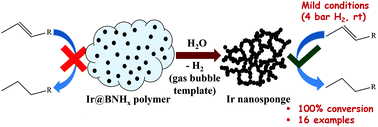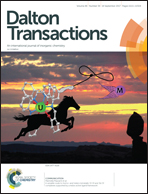Synthesis of mesoporous iridium nanosponge: a highly active, thermally stable and efficient olefin hydrogenation catalyst†
Abstract
Three dimensional porous structures offer high specific surface areas and large pore volumes, which enhance substrate diffusion within the porous structures and provide a large number of surface active sites. Such types of structures find applications in catalysis. Herein, we report a simple synthetic strategy for the preparation of iridium nanosponges by the capping agent dissolution method. An Ir@BNHx nanocomposite was prepared starting from different iridium precursors by a solid state reduction method using ammonia borane wherein iridium(0) nanoparticles are embedded in a BNHx polymer. Capping agent (here, the BNHx polymer) dissolution using water under ambient conditions resulted in the formation of a mesoporous iridium nanosponge. This iridium nanosponge exhibits a surface area of 33.5 m2 g−1. The iridium nanosponge was found to be catalytically active for hydrogenation of a variety of olefinic substrates including linear and cyclic alkenes and α,β-unsaturated esters under relatively mild conditions and exhibits high turnover frequencies. It was also found to exhibit much better catalytic activity as compared to other iridium based heterogeneous catalysts for olefin hydrogenation reactions. Additionally, catalyst recovery was achieved via simple filtration from the hydrogenation reaction mixture. The catalytically active surface area of iridium nanosponge was estimated using H2-temperature programmed desorption (TPD) experiments. Moreover, the catalyst was found to be thermally quite robust. The catalyst was recyclable over seven cycles of styrene hydrogenation and was found to be capable of hydrogenating 99% of styrene to ethyl benzene after seven cycles.



 Please wait while we load your content...
Please wait while we load your content...